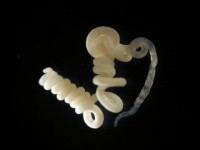Genus Olavius Rank Species Subclass Oligochaeta | Family Tubificidae Order Haplotaxida | |
 | ||
Similar Oligochaeta, Naididae, Solemya velum, Solemya, Paracatenula | ||
Olavius algarvensis is a gutless oligochaete worm.
Contents
Habitats and research
The worm lives in sediments in front the coast of the Italian island Elba. The existence of gutless worms was discovered in the 1970s/80s. They were first observed near Bermuda. Research on Oligochaete worms from the Pacific Ocean at Peru revealed 10 years ago that these worms lived from symbiotic bacteria. Recently Scientists from the Max Planck Institute for Marine Microbiology in Bremen studied the anatomy and physiology of O. algarvensis in detail.
Nutrition
O. algarvensis does not have any mouth, gut, kidney or similar organ. It is fed by symbiotic bacteria which live under its cuticle. An analysis of the genome and proteome of O. algarvensis by the means of metaproteomics and metabolomics revealed that this worm is able to metabolise carbon monoxide, hydrogen sulfide, malic acid and acetate with the help of its symbiotic bacteria. This is unique for marine organisms.
Properties of the symbiosis
The symbiotic bacteria which live with the worm O. algarvensis have unique properties. The delta-Proteobacterium ("delta-1 symbiont") is able to produce numerous Seleno- and Pyrroproteins, which contains the amino acids selenocysteine and pyrrolysine that are sometimes called the 21st and 22nd amino acids. This bacterium has the largest known proteome with selenoproteins and Pyl-containing proteins.
